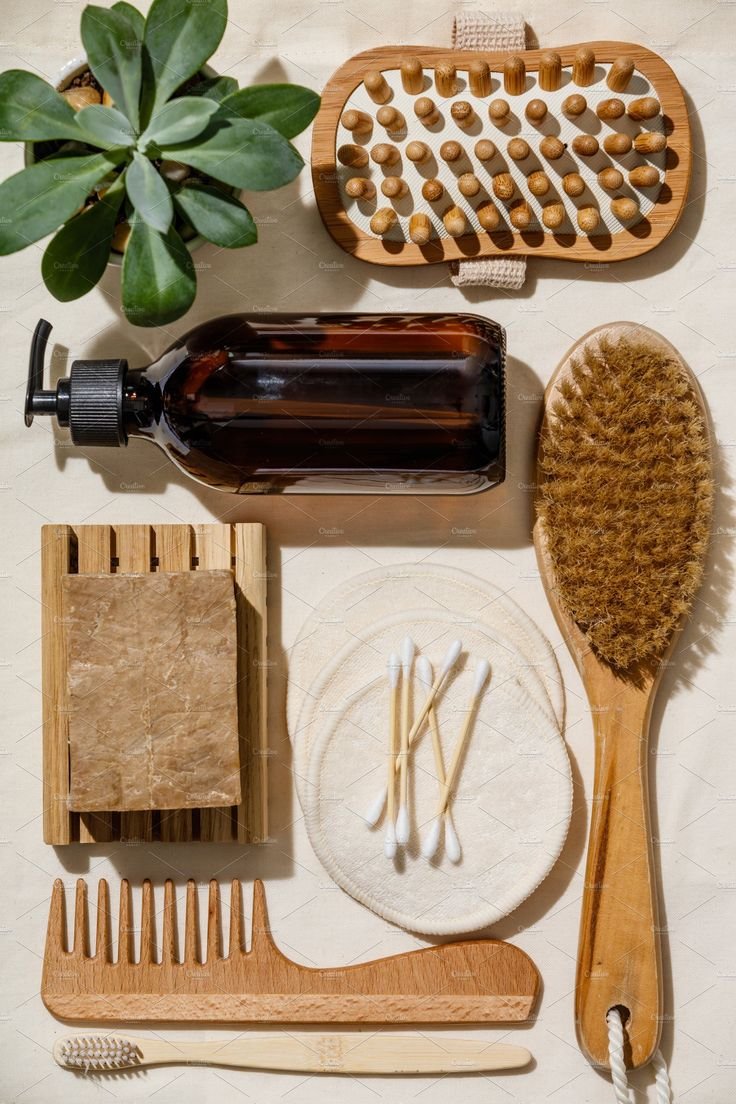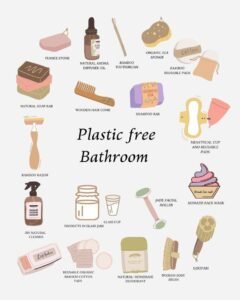Plastic-Free Bathroom: 10 Essential Tips and DIY Projects for a Zero-Waste Routine

Introduction
The bathroom is often overlooked when it comes to sustainability, yet it’s one of the most wasteful spaces in our homes. From single-use plastics to chemical-laden products, our daily routines contribute significantly to environmental pollution. Embracing a plastic-free bathroom not only benefits the planet but also promotes a healthier and more mindful lifestyle. By making conscious choices and implementing simple changes, you can transform your bathroom into a zero-waste haven without compromising on functionality or aesthetics.
Plastic-free bathrooms align with the growing movement toward sustainable living. They prioritize using reusable, biodegradable, and non-toxic products while minimizing reliance on disposable items. The shift doesn’t have to be overwhelming; small, incremental changes can lead to a significant reduction in waste. Moreover, many alternatives not only reduce environmental impact but also offer cost savings over time.
This guide will explore practical tips and DIY projects to help you eliminate plastic waste from your bathroom. Whether you’re a seasoned environmentalist or just starting your sustainability journey, these ideas will inspire you to make impactful changes. Let’s take the first step towards a greener future, one bathroom at a time.
1. Switch to Bar Soap and Shampoo Bars
Liquid soaps and shampoos often come in plastic bottles that contribute to landfill waste. Opt for bar soaps and shampoo bars, which are not only plastic-free but also long-lasting and often made with natural ingredients. Many brands offer options for various skin and hair types, ensuring you’ll find a product that suits your needs. Store them in a soap dish or a bamboo holder to keep them dry and extend their lifespan.
In addition to reducing plastic, bar soaps and shampoo bars typically have fewer chemicals, making them gentler on your skin and hair. They also save space in your bathroom and are ideal for travel since they’re lightweight and spill-proof. Look for local artisans or companies committed to sustainability to further support eco-friendly practices.
DIY Project: Create your own soap bars using natural ingredients like shea butter, coconut oil, and essential oils. Experiment with scents and colors to customize them for your preferences. If you’re feeling creative, use molds with fun shapes or add exfoliants like oatmeal or coffee grounds.
2. Replace Plastic Toothbrushes with Bamboo Alternatives
Traditional plastic toothbrushes take hundreds of years to decompose. Switching to bamboo toothbrushes is an easy and effective way to reduce your bathroom’s plastic footprint. Bamboo is biodegradable and renewable, making it an eco-friendly alternative. Look for brushes with plant-based bristles for a completely compostable product.
Bamboo toothbrushes are available in various sizes and designs, ensuring comfort and effectiveness. Some brands even offer subscription services, delivering new brushes at regular intervals to reduce waste and maintain hygiene.
DIY Project: Use old bamboo toothbrushes as garden markers or for cleaning hard-to-reach spots in your home. This extends their usefulness before composting. Personalize them with paint or labels for an added touch of creativity.
3. Opt for Refillable or Powdered Toothpaste
Toothpaste tubes are notoriously difficult to recycle. Refillable toothpaste jars or powdered toothpaste options are excellent plastic-free alternatives. These products often come in glass jars or metal tins, which are recyclable and reusable. They also tend to have simpler, more natural ingredients, making them a healthier choice for your oral care routine.
Powdered toothpaste is particularly convenient for travel, as it’s lightweight and mess-free. Many brands offer a variety of flavors, ensuring you’ll find one that suits your taste. Additionally, some companies provide refill programs to further minimize waste.
DIY Project: Make your own toothpaste by mixing baking soda, coconut oil, and a few drops of peppermint essential oil. Store it in a glass jar and scoop it out with a small spoon or spatula. For added benefits, incorporate activated charcoal or calcium carbonate to support oral health.
4. Ditch Disposable Razors
Disposable razors are another major contributor to bathroom waste. Invest in a high-quality safety razor with replaceable blades. Not only are they more sustainable, but they also provide a closer and smoother shave. Safety razors are made to last, and the blades are often recyclable, significantly reducing waste compared to plastic alternatives.
Many safety razors are designed with ergonomic handles for a comfortable grip, and they come in stylish finishes like chrome or rose gold. They may have a higher upfront cost, but the long-term savings make them a worthwhile investment.
DIY Project: Create a shaving cream using shea butter, coconut oil, and olive oil whipped together. This natural alternative nourishes your skin while shaving. Add a few drops of lavender or eucalyptus essential oil for a soothing, spa-like experience.
5. Use Reusable Makeup Remover Pads
Single-use cotton pads and makeup wipes generate significant waste. Switch to reusable makeup remover pads made from organic cotton or bamboo. These pads are washable and can be used multiple times, reducing waste and saving money.
Reusable pads are gentle on the skin and work effectively with micellar water, oil cleansers, or just water. Many come with a small laundry bag for easy washing, ensuring they stay clean and hygienic.
DIY Project: Sew your own makeup remover pads using soft fabric scraps like flannel or old cotton t-shirts. Add a few layers of fabric for durability. Personalize them by using patterns or embroidering small designs.
6. Try Plastic-Free Menstrual Products
Menstrual products like pads and tampons often contain plastic. Consider alternatives such as menstrual cups, reusable cloth pads, or period underwear. These options are not only eco-friendly but also more cost-effective in the long run. They’re also free from harmful chemicals, providing a safer option for your body.
Menstrual cups are made from medical-grade silicone and can last up to 10 years with proper care. Period underwear offers a comfortable and discreet alternative, and reusable pads come in various sizes and absorbencies to suit different needs.
DIY Project: If you’re skilled with a sewing machine, create your own reusable cloth pads using organic cotton and a waterproof liner for added protection. Choose colorful or patterned fabrics to make them visually appealing.
7. Invest in Sustainable Storage Solutions
Plastic containers and organizers are common in bathrooms. Replace them with glass jars, metal tins, or wooden boxes. These alternatives are durable, stylish, and free from harmful chemicals. They’re perfect for storing items like cotton swabs, bath salts, or hair accessories.
Look for vintage or thrifted containers to add character to your bathroom. You can also repurpose items from around your home, such as teacups or small baskets, for unique storage solutions.
DIY Project: Upcycle old mason jars or glass containers to store cotton swabs, bath salts, or other bathroom essentials. Decorate them with twine, chalk paint, or labels for a personal touch.
8. Make Your Own Cleaning Products
Many bathroom cleaning products come in plastic bottles and contain harsh chemicals. Making your own cleaners is a sustainable and healthier choice. Ingredients like vinegar, baking soda, and essential oils can effectively tackle grime and odors. Homemade cleaners are also customizable, allowing you to adjust scents and strengths to your preferences.
DIY Project: Mix equal parts vinegar and water with a few drops of tea tree oil in a glass spray bottle for an all-purpose bathroom cleaner. Use baking soda as a scrub for sinks and tubs. For mirrors, combine water, vinegar, and rubbing alcohol for a streak-free finish.
9. Choose Compostable Floss
Conventional dental floss is often made from nylon and comes in plastic containers. Look for compostable floss made from silk or plant-based materials, packaged in recyclable or refillable containers. These options are just as effective as traditional floss and better for the environment.
Compostable floss is gentle on gums and can be found in a variety of flavors, such as mint or cinnamon. Some brands also offer subscription services to make sustainable oral care even more convenient.
DIY Project: Store your floss in a small glass jar with a dispenser lid for a chic and eco-friendly alternative to plastic packaging. Decorate the jar with labels or a ribbon for a personalized touch.
10. Embrace Plastic-Free Packaging for Skincare
Many skincare products come in plastic tubes and bottles. Seek out brands that offer plastic-free packaging or make your own skincare products at home. Look for glass jars, metal tins, or cardboard tubes when purchasing products.
DIY Project: Create a moisturizing body butter using cocoa butter, shea butter, and almond oil. Whip the ingredients together and store them in a reusable glass jar for a luxurious, plastic-free skincare solution. Customize it with your favorite essential oils for a signature scent.
Conclusion
Transitioning to a plastic-free bathroom is a rewarding journey that benefits both the environment and your well-being. By adopting these tips and incorporating DIY projects into your routine, you can significantly reduce waste and embrace a more sustainable lifestyle. Each small change contributes to a larger impact, proving that sustainability starts at home.
The process of creating a plastic-free bathroom is not about perfection but progress. Celebrate each step, no matter how small, and use your efforts to inspire others. By combining mindful consumption with creativity, you can craft a bathroom that reflects your values and supports the planet. Together, we can make sustainability a cornerstone of modern living, starting with the spaces we use every day.





